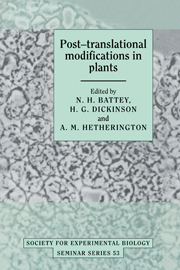Book contents
- Frontmatter
- Contents
- List of contributors
- List of abbreviations
- Preface
- Some roles of post-translational modifications in plants
- Signal transduction and protein phosphorylation in bacteria
- Roles of protein phosphorylation in animal cells
- The significance of post-translational modification of proteins by phosphorylation in the regulation of plant development and metabolism
- Post-translational modification of chloroplast proteins and the regulation of protein turnover
- Purification of a small phosphoprotein from chloroplasts and characterisation of its phosphoryl group
- Use of synthetic peptides to study G proteins and protein kinases within plant cells
- Activation of membrane-associated protein kinase by lipids, its substrates, and its function in signal transduction
- Distribution and function of Ca2+-dependent, calmodulin-independent protein kinases
- Phosphorylation of the plasma membrane proton pump
- The regulation of phosphoenolpyruvate carboxylase by reversible phosphorylation
- Protein phosphorylation and circadian rhythms
- Control of translation by phosphorylation of mRNP proteins in Fucus and Xenopus
- Regulation of plant metabolism by reversible protein (serine/threonine) phosphorylation
- Detection, biosynthesis and some functions of glycans N-linked to plant secreted proteins
- Biosynthesis, intracellular transport and processing of ricin
- Post-translational processing of concanavalin A
- The role of cell surface glycoproteins in differentiation and morphogenesis
- Ubiquitination of proteins during floral development and senescence
- Index
Protein phosphorylation and circadian rhythms
Published online by Cambridge University Press: 06 July 2010
- Frontmatter
- Contents
- List of contributors
- List of abbreviations
- Preface
- Some roles of post-translational modifications in plants
- Signal transduction and protein phosphorylation in bacteria
- Roles of protein phosphorylation in animal cells
- The significance of post-translational modification of proteins by phosphorylation in the regulation of plant development and metabolism
- Post-translational modification of chloroplast proteins and the regulation of protein turnover
- Purification of a small phosphoprotein from chloroplasts and characterisation of its phosphoryl group
- Use of synthetic peptides to study G proteins and protein kinases within plant cells
- Activation of membrane-associated protein kinase by lipids, its substrates, and its function in signal transduction
- Distribution and function of Ca2+-dependent, calmodulin-independent protein kinases
- Phosphorylation of the plasma membrane proton pump
- The regulation of phosphoenolpyruvate carboxylase by reversible phosphorylation
- Protein phosphorylation and circadian rhythms
- Control of translation by phosphorylation of mRNP proteins in Fucus and Xenopus
- Regulation of plant metabolism by reversible protein (serine/threonine) phosphorylation
- Detection, biosynthesis and some functions of glycans N-linked to plant secreted proteins
- Biosynthesis, intracellular transport and processing of ricin
- Post-translational processing of concanavalin A
- The role of cell surface glycoproteins in differentiation and morphogenesis
- Ubiquitination of proteins during floral development and senescence
- Index
Summary
Introduction
The basic cellular oscillator which controls the various circadian rhythms of cells and organisms is often called the ‘circadian clock’. Knowledge about the mechanism of this ‘clock’ is emerging only slowly, progress being made particularly in the analysis of the period (per) gene and its products in Drosophila and other animal organisms (reviews: Rosbash & Hall, 1989; Young et al., 1989; Hall, 1990). Earlier approaches to the analysis of the clock mechanism were based mainly on phase shifting experiments with perturbing pulses or on biochemical evidence of oscillatory changes. These data indicated that protein synthesis, membrane potential, Ca2+-calmodulin and possibly other second messenger systems had roles in the clock mechanism or in the input pathways (reviews: Edmunds, 1988; Rensing and Hardeland, 1990). Evidence for the involvement of protein phosphorylation in this mechanism has also been indirectly derived from treatments with agents affecting kinase or phosphatase activities and from measurements of circadian rhythmic protein phosphorylation (Schroeder-Lorenz & Rensing, 1987; Techel et al., 1990). In addition, phase shifting pulses of light and elevated temperatures cause – among other effects – changes of protein phosphorylation within the cell (Lauter & Russo, 1990; Nover, 1990).
There are numerous ‘downstream’ processes, so called ‘hands’ of the clock, which also oscillate and cannot easily be distinguished from oscillating parts of the mechanism. Circadian rhythms in the phosphorylation state of phosphoenolpyruvate carboxylase (Carter et al., 1991; Nimmo, this volume), for example, may represent such a hand.
- Type
- Chapter
- Information
- Post-translational Modifications in Plants , pp. 171 - 186Publisher: Cambridge University PressPrint publication year: 1993
- 6
- Cited by

